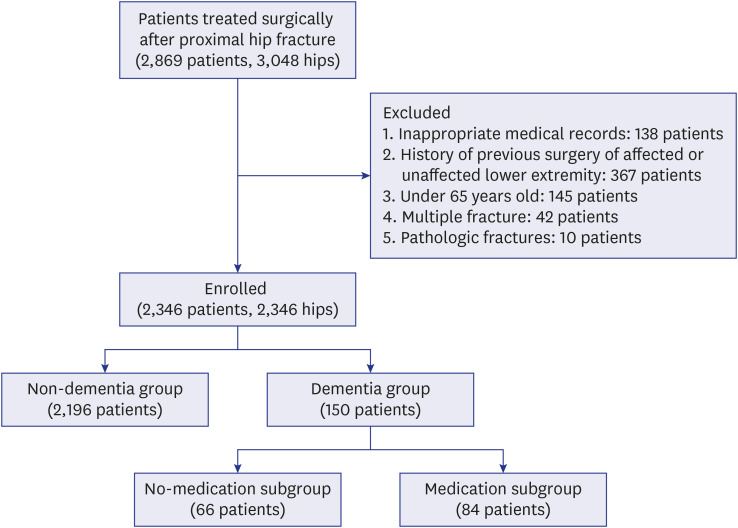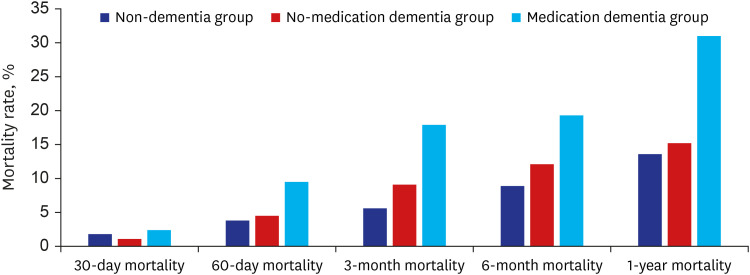J Korean Med Sci.
2021 Oct;36(38):e238. 10.3346/jkms.2021.36.e238.
Effect of Dementia on Postoperative Mortality in Elderly Patients with Hip Fracture
- Affiliations
-
- 1Department of Orthopaedic Surgery, Chung-Ang University College of Medicine, Seoul, Korea
- 2Department of Orthopaedic Surgery, Daejeon Eulji Medical Center, Eulji University School of Medicine, Daejeon, Korea
- 3Department of Orthopaedic Surgery, Gyeongsang National University Hospital, Jinju, Korea
- 4Department of Orthopaedic Surgery, Seoul National University Bundang Hospital, Seongnam, Korea
- KMID: 2520776
- DOI: http://doi.org/10.3346/jkms.2021.36.e238
Abstract
- Background
The aim of this study was to assess the prevalence of dementia as an underlying disease in elderly patients with hip fracture, to investigate the effect of dementia on postoperative mortality after surgery of hip fracture, and to analyze the differences in postoperative mortalities according to the severity of dementia through subgroup analysis.
Methods
This study selected 2,346 elderly patients who were diagnosed with unilateral intertrochanteric or femoral neck fractures who underwent surgery between January 2004 and December 2018. The patients were classified into the non-dementia group (2,196 patients) and dementia group (150 patients; no-medication [66 patients] and medication [84 patients] subgroups). The cumulative crude mortality rate was calculated, and 30-day, 60-day, 3-month, 6-month, and 1-year mortality rates were compared between the groups. A univariate regression test was performed using age, sex, diagnosis, surgery type, and Charlson's comorbidity index (CCI), as these variables had P values of < 0.10. Multivariate regression analysis was performed to identify independent risk factors associated with mortality.
Results
The 30-day, 60-day, 3-month, 6-month, and 1-year postoperative cumulative mortality rates were 1.8%, 3.8%, 5.6%, 8.9%, and 13.6%, respectively, in the non-dementia group, and 2%, 7.3%, 14%, 19.3%, and 24%, respectively, in the dementia group (P = 0.748, P = 0.048, P < 0.001, P < 0.001, and P = 0.001). The factors that affected the 1-year mortality were age (odds ratio [OR], 1.06; 95% confidence interval [CI], 1.02–1.08; P < 0.001), sex (OR, 2.68; 95% CI, 2.07–3.47; P < 0.001), CCI (OR, 1.34; 95% CI, 1.23–1.47; P < 0.001), and dementia (OR, 1.70; 95% CI, 1.46–1.08; P = 0.016). In subgroup analysis, severity of dementia influenced the 6-month mortality (OR, 1.41; 95% CI, 1.70–2.01; P = 0.018), and 1-year mortality (OR, 1.30; 95% CI, 1.17–1.90; P = 0.027).
Conclusion
In elderly hip fracture patients, the comparison between patients with and without dementia revealed that dementia was an independent risk factor for mortality at a minimum of 1 year of follow-up, and the severity of dementia in hip fracture patients was a risk factor for mortality within 6 months and 1 year, postoperatively.
Figure
Reference
-
1. Cha YH, Ha YC, Yoo JI, Min YS, Lee YK, Koo KH. Effect of causes of surgical delay on early and late mortality in patients with proximal hip fracture. Arch Orthop Trauma Surg. 2017; 137(5):625–630. PMID: 28321571.
Article2. Park YG, Jang S, Ha YC. Incidence, morbidity and mortality in patients older than 50 years with second hip fracture in a Jeju cohort study. Hip Pelvis. 2014; 26(4):250–255. PMID: 27536589.
Article3. Hasegawa Y, Suzuki S, Wingstrand H. Risk of mortality following hip fracture in Japan. J Orthop Sci. 2007; 12(2):113–117. PMID: 17393264.
Article4. Ireland AW, Kelly PJ, Cumming RG. Risk factor profiles for early and delayed mortality after hip fracture: analyses of linked Australian Department of Veterans' Affairs databases. Injury. 2015; 46(6):1028–1035. PMID: 25813734.
Article5. Härstedt M, Rogmark C, Sutton R, Melander O, Fedorowski A. Impact of comorbidity on 6-month hospital readmission and mortality after hip fracture surgery. Injury. 2015; 46(4):713–718. PMID: 25627481.
Article6. Bai J, Zhang P, Liang X, Wu Z, Wang J, Liang Y. Association between dementia and mortality in the elderly patients undergoing hip fracture surgery: a meta-analysis. J Orthop Surg. 2018; 13(1):298.
Article7. Miller BL, Seeley WW, Mychack P, Rosen HJ, Mena I, Boone K. Neuroanatomy of the self: evidence from patients with frontotemporal dementia. Neurology. 2001; 57(5):817–821. PMID: 11552010.
Article8. Elahi FM, Miller BL. A clinicopathological approach to the diagnosis of dementia. Nat Rev Neurol. 2017; 13(8):457–476. PMID: 28708131.
Article9. Doblhammer G, Fink A, Fritze T. Short-term trends in dementia prevalence in Germany between the years 2007 and 2009. Alzheimers Dement. 2015; 11(3):291–299. PMID: 25301681.
Article10. Mathillas J, Lövheim H, Gustafson Y. Increasing prevalence of dementia among very old people. Age Ageing. 2011; 40(2):243–249. PMID: 21258087.
Article11. Wimo A, Winblad B, Aguero-Torres H, von Strauss E. The magnitude of dementia occurrence in the world. Alzheimer Dis Assoc Disord. 2003; 17(2):63–67. PMID: 12794381.
Article12. Chiu HC, Chen CM, Su TY, Chen CH, Hsieh HM, Hsieh CP, et al. Dementia predicted one-year mortality for patients with first hip fracture: a population-based study. Bone Joint J. 2018; 100-B(9):1220–1226. PMID: 30168771.13. Jeong HG, Han C. Diagnosis and treatment of dementia in primary care. J Korean Med Assoc. 2013; 56(12):1104–1112.
Article14. Charlson ME, Pompei P, Ales KL, MacKenzie CR. A new method of classifying prognostic comorbidity in longitudinal studies: development and validation. J Chronic Dis. 1987; 40(5):373–383. PMID: 3558716.
Article15. Chang KH, Chung CJ, Lin CL, Sung FC, Wu TN, Kao CH. Increased risk of dementia in patients with osteoporosis: a population-based retrospective cohort analysis. Age (Dordr). 2014; 36(2):967–975. PMID: 24347180.
Article16. Draper B, Karmel R, Gibson D, Peut A, Anderson P. The Hospital Dementia Services Project: age differences in hospital stays for older people with and without dementia. Int Psychogeriatr. 2011; 23(10):1649–1658. PMID: 21902861.
Article17. Lai YC, Tang PL, Kuo TJ, Hsu CJ. Different impacts of dementia on two-year mortality after osteosynthesis and hemiarthroplasty in treating geriatric hip fractures. Arch Gerontol Geriatr. 2018; 79:116–122. PMID: 30196144.
Article18. Ruggiero C, Bonamassa L, Pelini L, Prioletta I, Cianferotti L, Metozzi A, et al. Early post-surgical cognitive dysfunction is a risk factor for mortality among hip fracture hospitalized older persons. Osteoporos Int. 2017; 28(2):667–675. PMID: 27717957.
Article19. Mehta KM, Yeo GW. Systematic review of dementia prevalence and incidence in United States race/ethnic populations. Alzheimers Dement. 2017; 13(1):72–83. PMID: 27599209.
Article20. Fansa A, Huff S, Ebraheim N. Prediction of mortality in nonagenarians following the surgical repair of hip fractures. Clin Orthop Surg. 2016; 8(2):140–145. PMID: 27247737.
Article21. Mitchell R, Harvey L, Brodaty H, Draper B, Close J. Hip fracture and the influence of dementia on health outcomes and access to hospital-based rehabilitation for older individuals. Disabil Rehabil. 2016; 38(23):2286–2295. PMID: 26765956.
Article
- Full Text Links
- Actions
-
Cited
- CITED
-
- Close
- Share
- Similar articles
-
- Postoperative Mortality and the Associated Factors in Elderly Patients with Hip Fracture
- Analysis of Missed Fractures by Bone Scan in Elderly Hip Fracture Patients with Osteoporosis
- Postoperative Mortality and the Associated Factors for Senile Hip Fracture Patients
- The Incidence and Related Factors of Delirium in Elderly Patients with Hip Fracture after Surgery
- The Analysis of Postoperative Mortality after Bipolar Hemiarthroplasty for Hip Fractures in the Elderly



